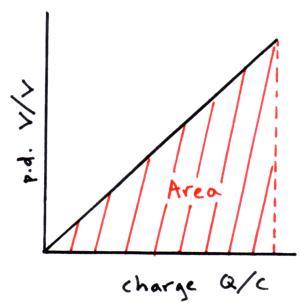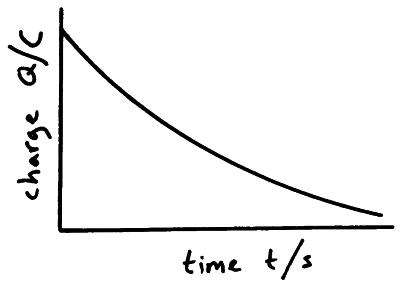Click here for capacitor questions and homework.
A capacitor is a charge storage device. Charges (Q) are measure in coulombs (C). A single electron carries a charge of 1.6 x 10-19 C.
A capacitor is two metal plates separated by an insulator (or dielectric).

The circuit symbol for a capacitor is;![]()
Capacitance
The capacitance of a capacitor is measured in farads (F). One farad is one coulomb of charge per volt (1 F = 1 CV-1).
C = capacitance measured in farads (F)
Q = charge measured in coulombs (C)
V = potential difference measured in volts (V)
1 farad is a a very large capacitance. Typically capacitors have a capacitance around the micro farad (10-6F), nano farad (10-9F), pico farad (10-12 F) sizes.
Energy stored by a capacitor
The charge (Q) stored on a capacitor is directly proportional to the potential difference (V) across the plates of the capacitor.

The area underneath the line on the graph is equal to the energy (E) stored on the capacitor measured in joules (J).

E = energy stored on the capacitor measured in joules (J)
Q = charge on the capacitor measured in coulombs (C)
V = potential difference measured in volts (V)
C = the capacitance of the capacitor measured in farads (F)
Capacitor discharge
As the capacitor discharges the electrons from the negative (-) plate flow to the positive (+) plate of the capacitor and a current flows in the circuit. The graph below shows the exponential decay curve when charge is plotted against time for a discharging capacitor.


Q =the charge on the capacitor at time ‘t’ measured in coulombs (C)
Q0 = the charge on the capacitor when t = 0 seconds measured in coulombs (C)
t = the time the capacitor has been discharging measured in seconds (s)
C = the capacitance of the capacitor measured in coulombs (C)
R = the resistance in the discharging circuit measured in ohms (W)
CR time constant
The CR time constant gives us an indication of how quickly the capacitor will discharge. If the CR time constant is large the capacitor will take a greater time to discharge than if the CR time constant is small.
CR time constant = capacitance x resistance
(seconds / s) (farads / F) (ohms / W)
The time constant is equal to the time it takes for the charge on a capacitor to reach 1/e (37 %) of its initial value. We can find a value for the CR time constant from a graph.





